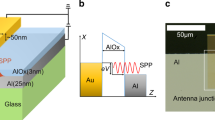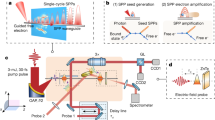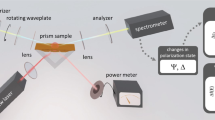Abstract
Surface plasmon polaritons, propagating bound oscillations of electrons and light at a metal surface, have great potential as information carriers for next-generation, highly integrated nanophotonic devices1,2. Since the term ‘active plasmonics’ was coined in 20043, a number of techniques for controlling the propagation of guided surface plasmon polariton signals have been demonstrated4,5,6,7. However, with sub-microsecond or nanosecond response times at best, these techniques are likely to be too slow for future applications in such fields as data transport and processing. Here we report that femtosecond optical frequency plasmon pulses can propagate along a metal–dielectric waveguide and that they can be modulated on the femtosecond timescale by direct ultrafast optical excitation of the metal, thereby offering unprecedented terahertz modulation bandwidth—a speed at least five orders of magnitude faster than existing technologies.
This is a preview of subscription content, access via your institution
Access options
Subscribe to this journal
Receive 12 print issues and online access
$209.00 per year
only $17.42 per issue
Buy this article
- Purchase on Springer Link
- Instant access to full article PDF
Prices may be subject to local taxes which are calculated during checkout



Similar content being viewed by others
References
Atwater, H. A. The promise of plasmonics. Sci. Am. 296, 56–63 (April 2007).
Ozbay, E. Plasmonics: Merging photonics and electronics at nanoscale dimensions. Science 311, 189–193 (2006).
Krasavin, A. V. & Zheludev, N. I. Active plasmonics: Controlling signals in Au/Ga waveguide using nanoscale structural transformations. Appl. Phys. Lett. 84, 1416–1418 (2004).
Nikolajsen, T., Leosson, K. & Bozhevolnyi, S. I. Surface plasmon polariton based modulators and switches operating at telecom wavelengths. Appl. Phys. Lett. 85, 5833–5835 (2004).
Lereu, A. L., Passian, A., Goudonnet, J-P., Thundat, T. & Ferrell, T. L. Optical modulation processes in thin films based on thermal effects of surface plasmons. Appl. Phys. Lett. 86, 154101 (2005).
Pala, R. A., Shimizu, K. T., Melosh, N. A. & Brongersma, M. L. A nonvolatile plasmonic switch employing photochromic molecules. Nano Lett. 8, 1506–1510 (2008).
Pacifici, D., Lezec, H. J. & Atwater, H. A. All-optical modulation by plasmonic excitation of CdSe quantum dots. Nature Photon. 1, 402–406 (2007).
Hendry, E. et al. Optical control over surface-plasmon-polariton-assisted THz transmission through a slit aperture. Phys. Rev. Lett. 100, 123901 (2008).
Dintinger, J., Robel, I., Kamat, P. V., Genet, C. & Ebbesen, T. W. Terahertz all-optical molecule-plasmon modulation. Adv. Mater. 18, 1645–1648 (2006).
Link, S. & El-Sayed, M. A. Spectral properties and relaxation dynamics of surface plasmon electronic oscillations in gold and silver nanodots and nanorods. J. Phys. Chem. B 103, 8410–8426 (1999).
Rotenberg, N., Betz, M. & van Driel, H. M. Ultrafast control of grating-assisted light coupling to surface plasmons. Opt. Lett. 33, 2137–2139 (2008).
Segall, B. Energy bands of aluminum. Phys. Rev. 124, 1797–1806 (1961).
Guo, C., Rodriguez, G., Lobad A. & Taylor, A. J. Structural phase transition of aluminum induced by electronic excitation. Phys. Rev. Lett. 84, 4493–4496 (2000).
Wilks, R. & Hicken, R. J. Transient optical polarization response of aluminium at an interband transition. J. Phys.: Condens. Matter. 16, 4607–4617 (2004).
Park, S., Pelton, M., Liu, M., Guyot-Sionnest, P. & Scherer, N. F. Ultrafast resonant dynamics of surface plasmons in gold nanorods. J. Phys. Chem. C 111, 116–123 (2007).
Georges, A. T. Coherent and incoherent multiple-harmonic generation from metal surfaces. Phys. Rev. A 54, 2412–2418 (1996).
Eesley, G. L. Generation of nonequilibrium electron and lattice temperatures in copper by picosecond laser pulses. Phys. Rev. B 33, 2144–2151 (1986).
Richardson, C. J. K. & Spicer, J. B. Short-time thermoelastic contributions to picosecond-time scale reflectivity measurements of metals. Appl. Phys. Lett. 80, 2895–2898 (2002).
Krasavin, A. V., MacDonald, K. F., Zheludev, N. I. & Zayats, A. V. High-contrast modulation of light with light by control of surface plasmon polariton wave coupling. Appl. Phys. Lett. 85, 3369–3371 (2004).
Palomba, S. & Novotny, L. Nonlinear excitation of surface plasmon polaritons by four-wave mixing. Phys. Rev. Lett. 101, 056802 (2008).
Krasavin, A. V., Zayats, A. V. & Zheludev, N. I. Active control of surface plasmon–polariton waves. J. Opt. A: Pure Appl. Opt. 7, S85–S89 (2005).
Feigenbaum, E. & Orenstein, M. Plasmon-soliton. Opt. Lett. 32, 674–676 (2007).
Acknowledgements
This work was supported by the Engineering and Physical Sciences Research Council (UK), the Department of Energy and National Science Foundation (USA), and the United States–Israel Binational Science Foundation. The authors would like to acknowledge the technical assistance of J.D. Mills.
Author information
Authors and Affiliations
Corresponding author
Rights and permissions
About this article
Cite this article
MacDonald, K., Sámson, Z., Stockman, M. et al. Ultrafast active plasmonics. Nature Photon 3, 55–58 (2009). https://doi.org/10.1038/nphoton.2008.249
Received:
Accepted:
Published:
Issue Date:
DOI: https://doi.org/10.1038/nphoton.2008.249
This article is cited by
-
Realizing multiple Fano resonance in an end-coupled semi-ring resonator-coupled waveguide structure
Journal of Optics (2023)
-
Multiple Fano resonance modes in an ultra-compact plasmonic waveguide-cavity system for temperature sensing
Optical and Quantum Electronics (2023)
-
Plasmonic Characteristics of the Graphene-Photonic Crystal Composite Structure in the IR Regime
Plasmonics (2023)
-
A plasmon modulator by directly controlling the couple of photon and electron
Scientific Reports (2022)
-
Thermal energy dependent transient permittivity of epsilon-near-zero material
Science China Physics, Mechanics & Astronomy (2022)



